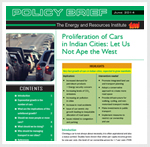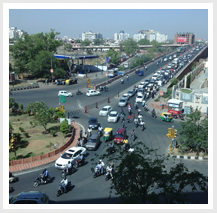|
|
|
| TERI releases policy brief on ‘Proliferation of cars in Indian cities’ |
|
TERI with the support from the Department for International Development (DfID), UK released a policy brief titled ‘Proliferation of Cars in Indian Cities: Let Us Not Ape the West’. The policy brief focuses on the issue of increasing car dependence in our cities and suggests policy measures necessary to move towards a path of sustainable mobility.
India currently has about 15 million cars, which is equivalent to 13 cars per 1,000 population. While this by itself is not high, it has |
 |
to be noted that it is a national average and some cities like Delhi, Chennai, and Coimbatore have more than 100 cars per 1,000 population. Different estimates show that the number of cars in India will increase to about 35 cars per 1,000 population by 2025. This would amount to about 45-60 million cars on our roads and in some cities more than 300 cars per 1,000 population.
This exponential growth in the number of cars will have serious implications for energy security, air pollution, road safety, equitable allocation of road space and will accentuate problems related to parking and congestion, which many of our cities have already started witnessing. These externalities make it necessary for us to explore whether economic growth can be decoupled from car ownership and the mobility needs of Indias citizens addressed without becoming more car dependent like the West. The policy brief highlights all key issues related to growing car ownership and suggests a way forward.
|
| Read the Policy Brief here |
|
| Read the related research paper here |
|
|
|
|
|
|
| Workshop on reducing vehicular emissions and improving fuel efficiency |
| A workshop was jointly organized with the International Council on Clean Transportation (ICCT), USA on 23 June 2014 in New Delhi to discuss vehicular technologies and fuel quality related issues for reducing emissions and improving fuel efficiency in the transportation sector. The event was supported by The Shakti Sustainable Energy Foundation. |
 |
|
|
| Read more about the workshop here
|
|
|
|
| Union Budget 2014 on urban development: Highlights |
|
| • |
A sum of INR 70.6 billion has been announced for the current fiscal year for developing ‘100 Smart Cities’, as satellite towns of larger cities and by modernizing the existing mid-sized cities.
|
|
| • |
The budget speaks about the need for ‘urban renewal’ and announced development of at least 500 habitations which will be provided support to renew their infrastructure and services in the next ten years.
|
|
|
|
|
 |
|
| • |
The budget also announced the Shyama Prasad Mukherji Rurban Mission (urbanization of the rural areas) through which people living in the rural areas can get efficient civic infrastructure and services. |
|
| • |
A ‘National Adaptation Fund’ for climate change will be established with an initial sanctioned amount of INR 1 billion.
|
|
| • |
The Pooled Municipal Debt Obligation Facility was set up in 2006 with participation of several banks to promote and finance infrastructure projects in urban areas on shared risk basis. The present corpus of this facility is INR 50 billion. With an objective of providing good infrastructure, including public transport, solid waste disposal, sewage treatment and drinking water in the urban areas, the corpus will be enlarged to INR 500 billion with extension of the facility by five years to March 31, 2019.
|
|
| • |
The budget stressed on initiating planning of metro rail projects in cities with population of more than two million. Government also indicated that it will encourage development of metro rail systems, including light rail systems through the PPP mode. A sum of INR 1 billion was announced for metro projects in Lucknow and Ahmedabad.
|
|
| • |
The budget proposed setting up of a Mission on Low Cost Affordable Housing which will be anchored in the National Housing Bank (NHB). A sum of INR 40 billion has been allocated for the mission.
|
|
| • |
Slum development has been included in the list of Corporate Social Responsibility (CSR) activities to encourage the private sector to contribute towards slum improvement
|
|
| • |
The budget announced that the Amritsar-Kolkata Industrial Corridor master planning will be completed expeditiously for the establishment of industrial smart cities in seven states of India. The master planning of three new smart cities in the Chennai-Bengaluru Industrial Corridor region, viz., Ponneri in Tamil Nadu, Krishnapatnam in Andhra Pradesh, and Tumkur in Karnataka will also be completed.
|
|
| • |
The budget announced setting up of a National Industrial Corridor Authority in Pune to coordinate the development of the industrial corridors, with smart cities linked to transport connectivity for driving India’s growth in manufacturing and urbanization. An initial corpus of INR 1 billion was announced for the same.
|
|
| • |
The budget announced a National Heritage City Development and Augmentation Yojana (HRIDAY) for conserving and preserving the heritage character of cities. In the first phase, the programme will be launched in cities like: Mathura, Amritsar, Gaya, Kanchipuram, Vellankani and Ajmer. An amount of INR 2 billion has been allocated for the same.
|
|
| Read the Budget 2014-15 Speech of the Minister for Finance |
|
|
|
|
| Railway Budget 2014: TERI’s view |
| This year’s railway budget has been different from the previous ones in terms of presenting an honest and true account of the current financial situation of the Indian Railways. Since the last few years, the operating ratio of the Indian Railways has risen to an abnormally high level of around 95%, resulting in a decline of internal generation of resources. Moreover, the investment in railway sector has been stagnant and capacity augmentation projects required for carrying additional traffic have suffered. |
 |
|
To counter this, the budget has for the first time highlighted the issue of structural reforms by separating the policy formulation and implementation functions of the Railway Board. This is a welcome step and the government should plan for separating regulatory, policy making, and executive functions gradually over a time period of 5-10 years. The budget emphasises on mobilisation of resources by leveraging investible funds of railway PSUs, encouraging private investment in railway infrastructure, and financing projects through the PPP mode. In addition, permitting FDI in creation of railway infrastructure has also been suggested. Although this is a welcome step, it requires setting up of a regulatory regime that instills confidence in private investors; Indian Railways will have to work towards creating such a regime.
Budget proposes a Railway University with an aim to introduce railway oriented subjects for graduation and skill development. TERI recommends that in addition to supporting development of the University, the Railways should also invest in and support research in railway technologies, sustainable energy, and energy efficiency studies in academic and research institutes.
TERI also suggests that the Indian Railways should promote and operationalise certain heritage lines which have a great tourism potential. For instance, a large portion of the UNESCO World heritage lines like Darjeeling Hill Railway (DHR), Kalka – Shimla narrow gauge line, etc. are not operational due to land-slides at several places. There is an urgent need for maintenance and up-keep on these routes.
The Government has planned to set up a Diamond Quadrilateral Network of High Speed Rail (HSR) connecting major metros and growth centres of the country; the first such corridor will be Mumbai - Ahmedabad. The decision of the government on the selection of the Mumbai-Ahmedabad route matches with the findings of a TERI study on HSR which developed the criteria to determine the suitability of a particular route for introduction of HSR based on passenger demand, per capita income and population growth. An amount of INR 1 billion has been budgeted for initiating work on HSR and the financing of HSR corridors has been planned through the PPP route. However, elsewhere in the world, it has been observed that such projects have been funded by the governments since they are highly capital intensive with very little short term financial benefits. TERI suggests reviewing the financial mechanisms for implementing the ambitious HSR initiative in the country and drawing learnings from the international experience. |
|
| Read the Budget 2014-15 Speech of the Minister for Railways
|
|
| Access presentations from the HSR study undertaken by TERI-ITPS:
|
|
| Criteria for HSR corridor selection
|
|
|
Need for railway capacity enhancement- HSR, a possible solution
|
|
|
Potential impacts on energy and emissions from HSR operations along the Ahmedabad- Mumbai corridor
|
|
|
|
| Register for the fourth ADB Transport Forum |
|
| The Asian Development Bank (ADB) is organising its biennial flagship transport event- ‘ADB Transport Forum 2014’ from 15 to 17 September 2014 at the ADB Headquarters, Manila, Philippines. This year the theme of the forum is "Transport in the Asian Century", with focus on key issues in the transport sector, as well as the future of sustainable mobility in Asia and the Pacific. |
|
| Registration details and draft program for the forum can be accessed here
|
|
|
|
